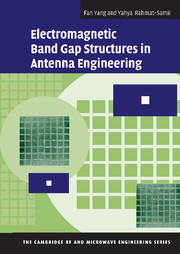Book contents
- Frontmatter
- Contents
- Preface
- Acknowledgements
- Abbreviations
- 1 Introduction
- 2 FDTD method for periodic structure analysis
- 3 EBG characterizations and classifications
- 4 Designs and optimizations of EBG structures
- 5 Patch antennas with EBG structures
- 6 Low profile wire antennas on EBG ground plane
- 7 Surface wave antennas
- Appendix: EBG literature review
- Index
- References
4 - Designs and optimizations of EBG structures
Published online by Cambridge University Press: 06 July 2010
- Frontmatter
- Contents
- Preface
- Acknowledgements
- Abbreviations
- 1 Introduction
- 2 FDTD method for periodic structure analysis
- 3 EBG characterizations and classifications
- 4 Designs and optimizations of EBG structures
- 5 Patch antennas with EBG structures
- 6 Low profile wire antennas on EBG ground plane
- 7 Surface wave antennas
- Appendix: EBG literature review
- Index
- References
Summary
After demonstrating some interesting characteristics of EBG structures, this chapter focuses on how to achieve these characteristics by properly designing the EBG structures. A parametric study on the mushroom-like EBG structure will be presented first. Then two popularly used planar EBG structures, mushroom-like EBG surface and uni-planar EBG surface, are compared with each other to develop some selection guidelines for potential applications. Novel EBG designs such as polarization-dependent EBG (PDEBG), compact spiral EBG, and stack EBG structures will also be studied. Furthermore, the particle swarm optimization (PSO) technique is implemented to design EBG surfaces. At the end of this chapter, some recent research trends are summarized, including space filling curve EBG surfaces, multi-band EBG designs and reconfigurable EBG structures.
Parametric study of a mushroom-like EBG structure
Electromagnetic properties of an EBG structure are determined by its physical dimensions. For a mushroom-like EBG structure shown in Fig. 4.1, there are four main parameters affecting its performance [1], namely, patch width W, gap width g, substrate thickness h, and substrate permittivity εr. In this section, the effects of these parameters are investigated one by one in order to obtain some engineering guidelines for EBG surface designs. Note that the vias' radius r has a trivial effect because it is very thin compared to the operating wavelength.
In this study, the FDTD/PBC technique [2–3] is used to characterize the reflection phase of the EBG structure. Normal incidence is considered here.
- Type
- Chapter
- Information
- Electromagnetic Band Gap Structures in Antenna Engineering , pp. 87 - 126Publisher: Cambridge University PressPrint publication year: 2008
References
- 2
- Cited by

